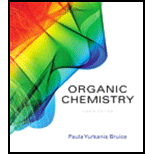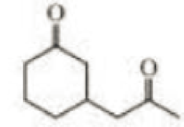
Organic Chemistry; Organic Chemistry Study Guide A Format: Kit/package/shrinkwrap
8th Edition
ISBN: 9780134581064
Author: Bruice, Paula Yurkanis
Publisher: Prentice Hall
expand_more
expand_more
format_list_bulleted
Concept explainers
Textbook Question
Chapter 17, Problem 7P
Describe how the following compound can be synthesized from compounds containing no more than six carbons.

Expert Solution & Answer
Want to see the full answer?
Check out a sample textbook solution
Students have asked these similar questions
When two solutions, one of 0.1 M KCl (I) and the other of 0.1 M MCl (II), are brought into contact by a membrane. The cation M cannot cross the membrane. At equilibrium, x moles of K+ will have passed from solution (I) to (II). To maintain the neutrality of the two solutions, x moles of Cl- will also have to pass from I to II. Explain this equality: (0.1 - x)/x = (0.1 + x)/(0.1 - x)
Calculate the variation in the potential of the Pt/MnO4-, Mn2+ pair with pH, indicating the value of the standard potential. Data: E0 = 1.12.
Given the cell: Pt l H2(g) l dis X:KCl (sat) l Hg2Cl2(s) l Hg l Pt. Calculate the emf of the cell as a function of pH.
Chapter 17 Solutions
Organic Chemistry; Organic Chemistry Study Guide A Format: Kit/package/shrinkwrap
Ch. 17.1 - Prob. 1PCh. 17.1 - Prob. 2PCh. 17.1 - Prob. 3PCh. 17.1 - Prob. 4PCh. 17.1 - Rank the compounds in each of the following groups...Ch. 17.2 - Explain why 92% of 2,4-pemtanedione exists as the...Ch. 17.3 - Draw the enol tautomers for each of the following...Ch. 17.3 - Prob. 8PCh. 17.4 - Prob. 9PCh. 17.4 - Prob. 10P
Ch. 17.5 - Show how the following compounds can be prepared...Ch. 17.6 - What compound is formed when a dilute solution of...Ch. 17.7 - Prob. 13PCh. 17.7 - Prob. 14PCh. 17.7 - How many stereoisomers are obtained from each of...Ch. 17.7 - Prob. 16PCh. 17.8 - Prob. 17PCh. 17.9 - Prob. 18PCh. 17.9 - What reagents should be used to prepare the...Ch. 17.10 - Prob. 20PCh. 17.10 - What aldehyde or ketone would be obtained when...Ch. 17.11 - Prob. 22PCh. 17.11 - How could you prepare the following compound using...Ch. 17.12 - Prob. 25PCh. 17.12 - What two carbonyl compound are required for the...Ch. 17.12 - Propose a mechanism for the following reaction:Ch. 17.13 - Draw the products of the following reactions:Ch. 17.13 - Prob. 29PCh. 17.13 - Prob. 30PCh. 17.14 - Prob. 31PCh. 17.15 - Write the mechanism for the reaction of a...Ch. 17.15 - Prob. 33PCh. 17.15 - Prob. 34PCh. 17.15 - Draw the product of the reaction of each of the...Ch. 17.16 - Draw the product obtained by heating each pair of...Ch. 17.16 - What two carbonyl compounds are needed to...Ch. 17.17 - Prob. 38PCh. 17.18 - Prob. 39PCh. 17.18 - Prob. 40PCh. 17.19 - Prob. 41PCh. 17.20 - Prob. 43PCh. 17.21 - Propose a mechanism for the formation of...Ch. 17.21 - Prob. 45PCh. 17.21 - a. If the biosynthesis of palmitic acid were...Ch. 17.21 - Prob. 47PCh. 17 - Prob. 48PCh. 17 - Prob. 49PCh. 17 - Number the following compounds in order of...Ch. 17 - The 1H NMR chemical shifts of nitromethane,...Ch. 17 - Prob. 52PCh. 17 - Draw the products of the following reactions: a....Ch. 17 - A racemic mixture of 2-methyl-1-phenyl-1-butanone...Ch. 17 - Draw the products of the following reaction:Ch. 17 - Prob. 56PCh. 17 - Prob. 57PCh. 17 - In the presence of excess base and excess halogen,...Ch. 17 - Identify A-L. (Hint: A shows three singles in its...Ch. 17 - Using cyclopentanone as the reactant, show the...Ch. 17 - Show how 4-methyl-3-hexanol can be synthesized...Ch. 17 - Show how the following compound can be synthesized...Ch. 17 - Show how the following compounds can be prepared...Ch. 17 - Prob. 64PCh. 17 - Prob. 65PCh. 17 - Indicate how each of the following compounds can...Ch. 17 - Prob. 67PCh. 17 - The ketone whose 1H NMR spectrum is shown here was...Ch. 17 - Indicate how the following compounds can be...Ch. 17 - Compound A with molecular formula C6H10 has two...Ch. 17 - Prob. 71PCh. 17 - Draw the products of the following reactions:Ch. 17 - Prob. 73PCh. 17 - a. Show how the amino acid alanine can be...Ch. 17 - Show how the following compounds can be...Ch. 17 - Prob. 76PCh. 17 - Explain why the following bromoketone forms...Ch. 17 - Prob. 78PCh. 17 - A carboxylic arid is formed when an -haloketone...Ch. 17 - An , -unsaturated carbonyl compound can be...Ch. 17 - What carbonyl compounds are required to prepare a...Ch. 17 - Prob. 82PCh. 17 - A Cannizzaro reaction is the reaction of an...Ch. 17 - Propose a mechanism for each of the following...Ch. 17 - The following reaction is known as the benzoni...Ch. 17 - Prob. 86PCh. 17 - Prob. 87PCh. 17 - Prob. 88PCh. 17 - Prob. 89PCh. 17 - Prob. 90PCh. 17 - Propose a mechanism for the following reaction:Ch. 17 - What reagents are required to convert the reactant...Ch. 17 - Starting with bromocyclohexane, how can each of...Ch. 17 - Describe how the following compounds can be...Ch. 17 - Prob. 4PCh. 17 - Describe three ways to synthesize the following...Ch. 17 - Explain why 92% of 2.4-pentanedione exists as the...Ch. 17 - Describe how the following compound can be...Ch. 17 - Prob. 8PCh. 17 - Prob. 9PCh. 17 - Prob. 10PCh. 17 - Show how the following compounds can be...
Knowledge Booster
Learn more about
Need a deep-dive on the concept behind this application? Look no further. Learn more about this topic, chemistry and related others by exploring similar questions and additional content below.Similar questions
- The decimolar calomel electrode has a potential of 0.3335 V at 25°C compared to the standard hydrogen electrode. If the standard reduction potential of Hg22+ is 0.7973 V and the solubility product of Hg2Cl2 is 1.2x 10-18, find the activity of the chlorine ion at this electrode.Data: R = 8.314 J K-1 mol-1, F = 96485 C mol-1, T = 298.15 K.arrow_forward2. Add the following group of numbers using the correct number of significant figures for the answer. Show work to earn full credit such as rounding off the answer to the correct number of significant figures. Replace the question marks with the calculated answers or write the calculated answers near the question marks. 10916.345 37.40832 5.4043 3.94 + 0.0426 ? (7 significant figures)arrow_forwardThe emf at 25°C of the cell: Pt l H2(g) l dis X:KCl (sat) l Hg2Cl2(s) l Hg l Pt was 612 mV. When solution X was replaced by normal phosphate buffer solution with a pH of 6.86, the emf was 741 mV. Calculate the pH of solution X.arrow_forward
- Indicate how to calculate the potential E of the reaction Hg2Cl2(s) + 2e ⇄ 2Hg + 2Cl- as a function of the concentration of Cl- ions. Data: the solubility product of Hg2Cl2.arrow_forwardHow can Beer’s Law be used to determine the concentration in a selected food sample. Provide an in-depth discussion and examples of this.arrow_forwardb) H3C- H3C Me CH 3 I HN Me H+arrow_forward
- Using Luther's rule, determine the reference potentials of the electrodes corresponding to the low stability systems Co³+/Co and Cr²+/Cr from the data in the table. Electrodo ΕΝ Co²+/Co Co3+/Co²+ -0,28 +1,808 Cr³+ / Cr -0,508 Cr3+ / Cr²+ -0,41arrow_forwardThe molecule PYRIDINE, 6tt electrons and is there pore aromuntre and is Assigned the Following structure contenus Since aromatk moleculey undergo electrophilic allomatic substitution, Pyridine should undergo The Following reaction + HNO3 12504 a. write all of the possible Mononitration Products that could Result From this roaction Based upon the reaction the reaction mechanism determine which of these producty would be the major Product of the hegetionarrow_forwardUsing Benzene as starting materia Show how each of the Following molecules could Ve synthesked 9. CHI d. 10450 b 0 -50311 ८ City -5034 1-0-650 e NO2arrow_forward
- BA HBr of the fol 1)=MgCI 2) H₂O major NaOEt Ts Cl Py (pyridine) 1) 03 2) Me2S 1arrow_forward4. Provide a clear arrow-pushing mechanism for the following reactions. Do not skip proton transfers, do not combine steps, and make sure your arrows are clear enough to be interpreted without ambiguity. a) NHBoc ⚫OBn HO. H3C CO2CH3 -OBn H3C H3C. H3C. NHBOC CI CO2CH3arrow_forwardDraw structures of the following compounds and identify their role: mCPBA (MCPBA) DMS Py 9-BBN LAH Sia₂BH TsCI PCC t-BuOK LDA MeLi n-BuLi DMSO DMF Sodium Borohydride Lithium DiisopropylAmide 2arrow_forward
arrow_back_ios
SEE MORE QUESTIONS
arrow_forward_ios
Recommended textbooks for you

How to Design a Total Synthesis; Author: Chemistry Unleashed;https://www.youtube.com/watch?v=9jRfAJJO7mM;License: Standard YouTube License, CC-BY